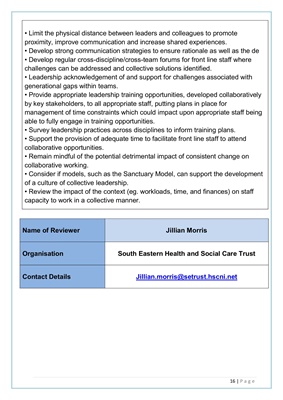
16 | P a g e
• Limit the physical distance between leaders and colleagues to promote
proximity, improve communication and increase shared experiences.
• Develop strong communication strategies to ensure rationale as well as the de
• Develop regular cross-discipline/cross-team forums for front line staff where
challenges can be addressed and collective solutions identified.
• Leadership acknowledgement of and support for challenges associated with
generational gaps within teams.
• Provide appropriate leadership training opportunities, developed collaboratively
by key stakeholders, to all appropriate staff, putting plans in place for
management of time constraints which could impact upon appropriate staff being
able to fully engage in training opportunities.
• Survey leadership practices across disciplines to inform training plans.
• Support the provision of adequate time to facilitate front line staff to attend
collaborative opportunities.
• Remain mindful of the potential detrimental impact of consistent change on
collaborative working.
• Consider if models, such as the Sanctuary Model, can support the development
of a culture of collective leadership.
• Review the impact of the context (eg. workloads, time, and finances) on staff
capacity to work in a collective manner.
Name of Reviewer
Jillian Morris
Organisation
South Eastern Health and Social Care Trust
Contact Details
jillian.morris@setrust.hscni.net